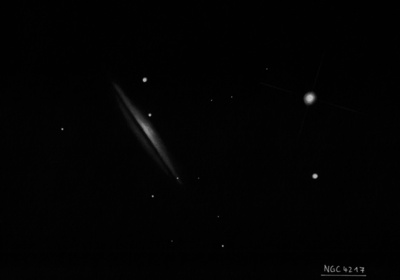
William Herschel discovered NGC 4217 = H II-748 = h1149 on 10 Apr 1788 (sweep 830) and recorded "pB, pL, sp and in a line with two stars." JH made 5 observations and logged (sweep 255) "pB, vmE in pos = 225° by measure; 5' long, 1' br; 2 stars near and a large star preceding." on 15 Mar 1849, LdR or observing assistant George Stoney described it as a "Ray with split [dark lane] in the direction of the major axis".
300/350mm - 13.1" (4/12/86): moderately bright, pretty edge-on 4:1 SW-NE. A mag 9 star is off the NE edge 2.2' from the center and a mag 11.5 star is just north of the core 0.8' from center. Located 6.2' E of mag 7.3 SAO 44092. Forms a pair with NGC 4226 7' SE.
900/1200mm - 48" (4/23/17): bright, very large, striking edge-on ~4.5'x1.0' SW-NE, large bright core that bulges near the center but no distinct nucleus. The galaxy is bisected by a beautiful, relatively wide dust lane that slices through the entire length of the galaxy, only losing contrast at the very tips! The brightest portion, including the core, is on the north side (northwest facing) of the dust lane. The cut off section of the galaxy on the south side (southeast facing) of the the dust lane is fairly thin and low surface brightness, though slightly brighter at the center/core. A mag 14.8 star is at the southwest tip of the galaxy. A mag 11.6 star is at the edge of the halo on the north side [50" from center] and a 9th magnitude star is 2.3' NNE of center. The galaxy is situated 6' E of mag 7.2 HD 106556, though this star was kept outside the field. NGC 4226 lies 7' SE. Member of the M109 (NGC 3992) group = LGG 258.
Notes by Steve Gottlieb